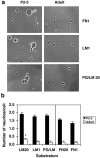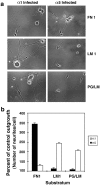Adult neuronal regeneration induced by transgenic integrin expression
- PMID: 11425905
- PMCID: PMC6762359
- DOI: 10.1523/JNEUROSCI.21-13-04782.2001
Adult neuronal regeneration induced by transgenic integrin expression
Abstract
In a variety of adult CNS injury models, embryonic neurons exhibit superior regenerative performance when compared with adult neurons. It is unknown how young neurons extend axons in the injured adult brain, in which adult neurons fail to regenerate. This study shows that cultured adult neurons do not adapt to conditions that are characteristic of the injured adult CNS: low levels of growth-promoting molecules and the presence of inhibitory proteoglycans. In contrast, young neurons readily adapt to these same conditions, and adaptation is accompanied by an increase in the expression of receptors for growth-promoting molecules (receptors of the integrin family). Surprisingly, the regenerative performance of adult neurons can be restored to that of young neurons by gene transfer-mediated expression of a single alpha-integrin.
Figures




References
-
- Andersen LB, Schreyer DJ. Constitutive expression of GAP-43 correlates with rapid, but not slow regrowth of injured dorsal root axons in the adult rat. Exp Neurol. 1999;155:157–164. - PubMed
-
- Bandtlow CE, Loschinger J. Developmental changes in neuronal responsiveness to the CNS myelin-associated neurite growth inhibitor NI-35/250. Eur J Neurosci. 1997;9:2743–2752. - PubMed
-
- Bates CA, Stelzner DJ. Extension and regeneration of corticospinal axons after early spinal injury and the maintenance of corticospinal topography. Exp Neurol. 1993;123:106–117. - PubMed
-
- Bomze HM, Bulsara KR, Iskandar BJ, Caroni P, Pate Skene JH. Spinal axon regeneration evoked by replacing two growth cone proteins in adult neurons. Nat Neurosci. 2001;4:38–43. - PubMed
-
- Brewer GJ, Torricelli JR, Evege EK, Price PJ. Optimized survival of hippocampal neurons in B27-supplemented Neurobasal, a new serum-free medium combination. J Neurosci Res. 1993;35:567–576. - PubMed
Publication types
MeSH terms
Substances
Grants and funding
LinkOut - more resources
Full Text Sources
